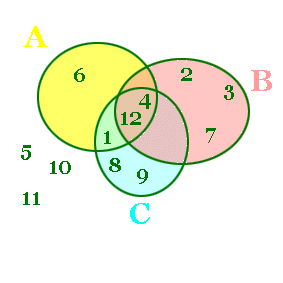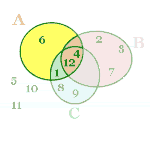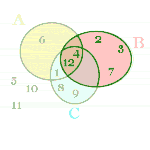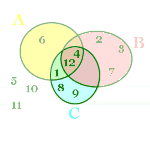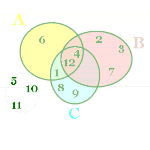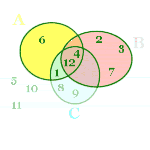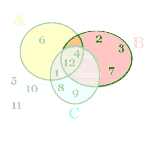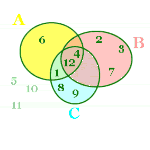Events and Set Operations
|
Mentor: We can look at a dice game to understand an event in probability. If a player wins when a six-sided die rolls a 1 or 2, we can say: "The event of the player winning happens in two outcomes out of six." Sometimes people draw pictures for events, circling or highlighting all the outcomes for each event.
Mentor: Let us consider one more game as an example. In this game, four players share a twelve-sided die. Player A (Anton) wins if the die shows 1, 4, 6, or 12. Player B (Boris) wins if the die shows 2, 3, 4, 7 or 12. Player C (Chris) wins if the die shows 1, 4, 8, 9, or 12. Player D (Dorothy) wins if none of the other players win. I will describe several events to demonstrate how convenient the diagrams can be. First try to find the probabilities without looking at the diagrams: this way you will see which of them are hard to find without the diagrams. Find the probabilities of the events listed in the table. The corresponding diagrams and the answers are also in the table. Instead of writing: "The probability of Event A is .33" we can write simply P(A)=.33 The answers follow from counting the outcomes, out of twelve total.
Event A: Player A wins
P(A)=4/12=1/3 Event B: Player B wins
P(B)=5/12 Event C: Player C wins
P(C)=5/12 Event D: Player D wins
P(D)=3/12=1/4 Event E: Player A or Player B wins (there is a special short notation for this: E = A U B which reads: "Event E is equal to the union of Events A and B)
P(E)=7/12 Event F: Player B wins but Player C does not win (the special notation for this is F = B\C which reads: "Event F is equal to Event B minus Event C")
P(F)=3/12=1/4
Event G: Both Player A and Player C win (the notation for that is
P(G)=3/12=1/4 Event H: Player D does not win (the notation here is H = D C which reads: "Event H is equal to the complement of Event D").
P(H)=9/12=3/4 |


